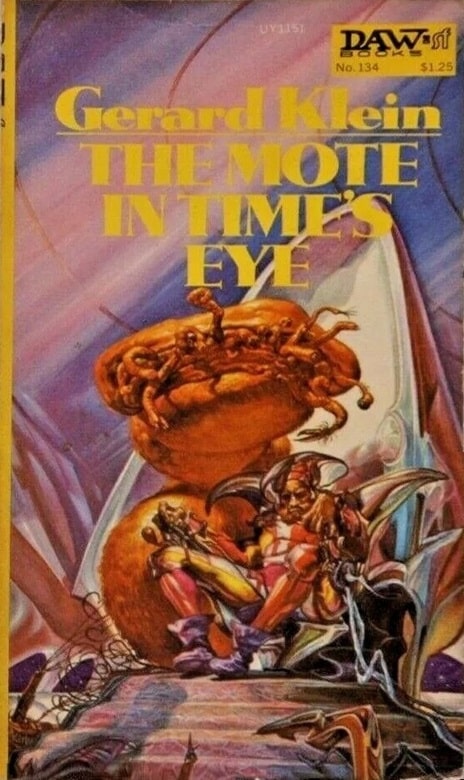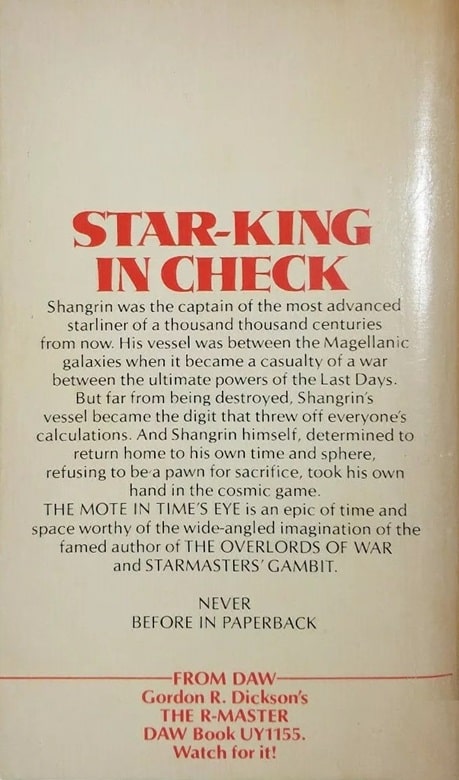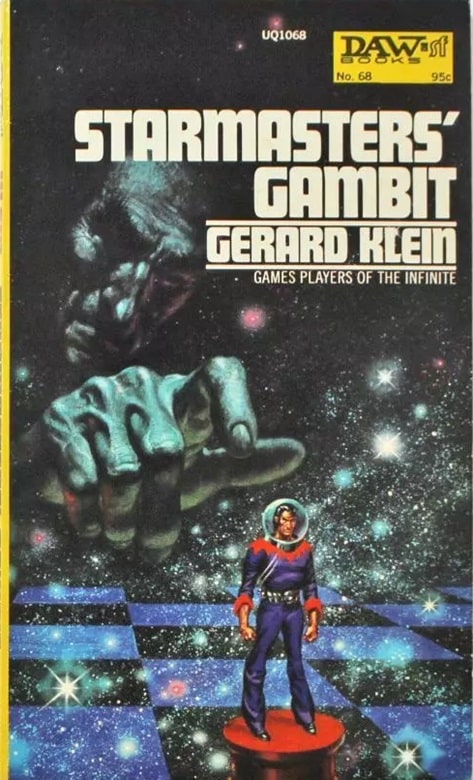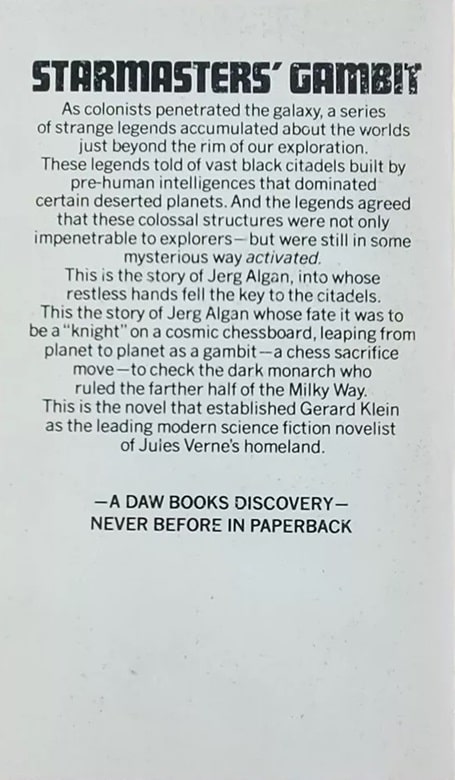Adventure in the Magellanic Cloud: The Mote in Time’s Eye by Gérard Klein
 |
 |
The Mote in Time’s Eye (DAW, January 1975). Cover by Josh Kirby
This is the latest in a series of posts I’m doing covering relatively obscure SF novels of the ‘70s and ‘80s. This novel was first published in French in 1965, but as it didn’t appear in English until 1975, I figure it fits this series.
One of the things on the good side of the Donald A. Wollheim ledger is his willingness to publish SF in translation. This was one of four novels by Gérard Klein that DAW books published. (Perhaps half a dozen translated short stories appeared in various places.)
Gérard Klein was born in 1937. He began publishing SF at the age of 18, and he seems to have mostly stopped in the mid-70s. He has also been a significant anthologist, and a critic, receiving the Pilgrim Award in 2005 for his scholarly work. His day job was as an economist. He is still alive, now 86 years old.
[Click the images to eye bigger versions.]
 |
 |
Starmasters’ Gambit (DAW, August 1973). Cover by Kelly Freas
The Science Fiction Encyclopedia offers some praise for his early novel Starmaster’s Gambit, and for much of his short fiction, calling it “delicately crafted.” The novel at hand, alas, doesn’t deserve such praise. Let me say, however, that as I read it in translation, it is possible that some of its faults are not due to Klein.
This novel, along with Starmaster’s Gambit, was translated by C. J. Richards. The Day Before Tomorrow was translated by P. J. Sokolowski, and The Overlords of War was translated by John Brunner. This last novel was first published in English as a Doubleday hardcover, though DAW did reprint it.
The Mote in Time’s Eye was first published in French as Les Tueurs du Temps in 1965, under the pseudonym Gilles d’Argyre. The French title means something like The Killers of Time. The English translation appeared in 1975. The English title that Wollheim chose for it was transparently, to me, an attempt to capitalize on the very popular 1974 novel by Larry Niven and Jerry Pournelle, The Mote in God’s Eye.
The novel concerns the Vasco, an exploration/trading starship from the Lesser Magellanic Cloud, which has just completed a 12 year mission to the Greater Magellanic Cloud and is returning home. We learn that their civilization, which has spread across the Lesser Cloud, is human, and was colonized from the “Home Galaxy” — obviously, from Earth, but millions of years have passed. (Though, as the name of the starship suggests, they still remember Vasco da Gama!) Now they happen into the center of a battle between two great Intergalactic civilizations from the even farther future, and they are propelled millions of years into the past.
The Captain is a huge blustering tyrant named Varun Shangrin. His first mate is Gregory, a more cautious man, and overtly loyal to Shangrin but also possibly a tool of the mission’s financial sponsors. Other important characters include Gregory’s lover, Norma, and a scientist named Smirno. Finally, there is a crablike alien, the Runi, who was sort of kidnapped by Shangrin from his planet, via the lure of chess, which fascinates the Runi.
Once the people on the ship realize they are not millions of years in their past, there is a certain panic and an uprising against Shangrin. But soon they realize he might be their only chance to return to their time. The ship comes eventually to a planet, on which there is a war between the decadent city inhabitants and the less powerful people of the plains. Shangrin uses the ship’s advanced technology to first defeat, then join, the plains people, with the object of overthrowing the cities and then finding the aliens who are responsible for throwing their ship back in time — for it becomes clear that there is evidence that these aliens are involved in the wars that have sprung up on multiple planets in this area.
The novel bashes forward, with various controversies on board the Vasco, with intrigue involving the Runi, with the discovery of a buried ship on the original planet they have come to… and, inevitably, there is a confrontation with some superior aliens, who have an offer for the Magellanics. And, you know, there’s a hint of some potentially neat stuff here, but it’s all lost in the fog of clumsy action scenes, utterly absurd science, implausible character motivation, and poor writing (some of which, I imagine, may have been the translator’s fault.)
In the end, I found the novel too silly, and at times boring. Not really a work that does its author much honor.
Rich Horton’s last article for us was an obituary for Vernor Vinge. His website is Strange at Ecbatan. Rich has written over 200 articles for Black Gate, see them all here.